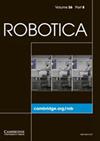Selective 6D grasping with a collision avoidance system based on point clouds and RGB+D images
IF 2.7
4区 计算机科学
Q3 ROBOTICS
引用次数: 0
Abstract
Abstract In recent years, deep learning-based robotic grasping methods have surpassed analytical methods in grasping performance. Despite the results obtained, most of these methods use only planar grasps due to the high computational cost found in 6D grasps. However, planar grasps have spatial limitations that prevent their applicability in complex environments, such as grasping manufactured objects inside 3D printers. Furthermore, some robotic grasping techniques only generate one feasible grasp per object. However, it is necessary to obtain multiple possible grasps per object because not every grasp generated is kinematically feasible for the robot manipulator or does not collide with other close obstacles. Therefore, a new grasping pipeline is proposed to yield 6D grasps and select a specific object in the environment, preventing collisions with obstacles nearby. The grasping trials are performed in an additive manufacturing unit that has a considerable level of complexity due to the high chance of collision. The experimental results prove that it is possible to achieve a considerable success rate in grasping additive manufactured objects. The UR5 robot arm, Intel Realsense D435 camera, and Robotiq 2F-140 gripper are used to validate the proposed method in real experiments.基于点云和RGB+D图像的避碰系统的选择性6D抓取
近年来,基于深度学习的机器人抓取方法在抓取性能上已经超越了解析方法。尽管获得了结果,但由于6D抓点的计算成本高,这些方法大多只使用平面抓点。然而,平面抓取有空间限制,阻碍了其在复杂环境中的适用性,例如在3D打印机中抓取制造物体。此外,一些机器人抓取技术对每个物体只产生一个可行的抓取。然而,对于每个物体,需要获得多个可能的抓取,因为并非每个抓取对机器人机械手来说都是运动学上可行的,或者不会与其他近距离障碍物发生碰撞。因此,提出了一种新的抓取管道,产生6D抓取并在环境中选择特定的物体,防止与附近的障碍物碰撞。抓握试验是在一个增材制造单元中进行的,由于碰撞的可能性很大,因此具有相当大的复杂性。实验结果表明,该方法可以获得较高的抓取成功率。采用UR5机械臂、Intel Realsense D435相机和Robotiq 2F-140夹持器在实际实验中验证了所提出的方法。
本文章由计算机程序翻译,如有差异,请以英文原文为准。
求助全文
约1分钟内获得全文
求助全文
来源期刊

Robotica
工程技术-机器人学
CiteScore
4.50
自引率
22.20%
发文量
181
审稿时长
9.9 months
期刊介绍:
Robotica is a forum for the multidisciplinary subject of robotics and encourages developments, applications and research in this important field of automation and robotics with regard to industry, health, education and economic and social aspects of relevance. Coverage includes activities in hostile environments, applications in the service and manufacturing industries, biological robotics, dynamics and kinematics involved in robot design and uses, on-line robots, robot task planning, rehabilitation robotics, sensory perception, software in the widest sense, particularly in respect of programming languages and links with CAD/CAM systems, telerobotics and various other areas. In addition, interest is focused on various Artificial Intelligence topics of theoretical and practical interest.
 求助内容:
求助内容: 应助结果提醒方式:
应助结果提醒方式:


